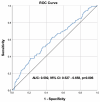The Prognostic Significance of the Pan-Immune-Inflammation Value in Patients with Heart Failure with Reduced Ejection Fraction
- PMID: 40647616
- PMCID: PMC12249291
- DOI: 10.3390/diagnostics15131617
The Prognostic Significance of the Pan-Immune-Inflammation Value in Patients with Heart Failure with Reduced Ejection Fraction
Abstract
Objective: We aimed to investigate the association between the pan-immune-inflammation value (PIV) and mortality in patients with heart failure with a reduced ejection fraction (HFrEF), along with clinical and biochemical parameters. Methods: In this retrospective cohort study, 419 patients diagnosed with HFrEF between January 2014 and December 2023 were analyzed. Data on demographic features, comorbidities, cardiac parameters [New York Heart Association (NYHA) classification, left ventricular ejection fraction (LVEF), ventricular dimensions], medication use, and laboratory findings (PIV, N-terminal pro-B-type natriuretic peptide [NT-proBNP], electrolytes, and complete blood count) were collected from institutional and national records. Results: Mortality occurred in 22.91% of patients. PIV > 696 was significantly associated with mortality (sensitivity: 37.5%, specificity: 78.64%, p = 0.006), but it was not an independent predictor in multivariate analysis. Instead, low body mass index (BMI), increased end-systolic diameter, reduced LVEF, advanced NYHA class (III/IV), elevated NT-proBNP, hyponatremia, and lymphopenia were identified as independent predictors (all p < 0.001). Conclusions: Although PIV was associated with mortality in patients with HFrEF, it did not independently predict outcomes beyond established risk factors. These results suggest that while inflammation may contribute to HFrEF pathophysiology, traditional clinical and biochemical markers remain more reliable for prognostication.
Keywords: biomarkers; heart failure; inflammation; mortality; prognosis; systolic.
Conflict of interest statement
The authors declare no competing interests. The funders had no role in study’s design, in data collection and analysis, in the decision to publish, or in the preparation of the manuscript.
Figures
Similar articles
-
The comparative and added prognostic value of biomarkers to the Revised Cardiac Risk Index for preoperative prediction of major adverse cardiac events and all-cause mortality in patients who undergo noncardiac surgery.Cochrane Database Syst Rev. 2021 Dec 21;12(12):CD013139. doi: 10.1002/14651858.CD013139.pub2. Cochrane Database Syst Rev. 2021. PMID: 34931303 Free PMC article.
-
Combination pharmacotherapies for cardiac reverse remodeling in heart failure patients with reduced ejection fraction: A systematic review and network meta-analysis of randomized clinical trials.Pharmacol Res. 2021 Jul;169:105573. doi: 10.1016/j.phrs.2021.105573. Epub 2021 Mar 22. Pharmacol Res. 2021. PMID: 33766629
-
Continuous infusion versus bolus injection of loop diuretics for acute heart failure.Cochrane Database Syst Rev. 2024 May 22;5(5):CD014811. doi: 10.1002/14651858.CD014811.pub2. Cochrane Database Syst Rev. 2024. PMID: 38775253 Free PMC article.
-
Systemic Inflammatory Response Syndrome.2025 Jun 20. In: StatPearls [Internet]. Treasure Island (FL): StatPearls Publishing; 2025 Jan–. 2025 Jun 20. In: StatPearls [Internet]. Treasure Island (FL): StatPearls Publishing; 2025 Jan–. PMID: 31613449 Free Books & Documents.
-
What is the value of routinely testing full blood count, electrolytes and urea, and pulmonary function tests before elective surgery in patients with no apparent clinical indication and in subgroups of patients with common comorbidities: a systematic review of the clinical and cost-effective literature.Health Technol Assess. 2012 Dec;16(50):i-xvi, 1-159. doi: 10.3310/hta16500. Health Technol Assess. 2012. PMID: 23302507 Free PMC article.
References
-
- Braunwald E. Braunwald’s Heart Disease. WB Saunders Elsevier; Philadelphia, PA, USA: 2012.
-
- Yancy C.W., Jessup M., Bozkurt B., Butler J., Casey D.E., Jr., Drazner M.H., Fonarow G.C., Geraci S.A., Horwich T., Januzzi J.L., et al. 2013 ACCF/AHA guideline for the management of heart failure: A report of the American College of Cardiology Foundation/American Heart Association Task Force on Practice Guidelines. J. Am. Coll. Cardiol. 2013;62:e147–e239. doi: 10.1016/j.jacc.2013.05.019. - DOI - PubMed
-
- McDonagh T.A., Metra M., Adamo M., Gardner R.S., Baumbach A., Böhm M., Burri H., Butler J., Čelutkienė J., Chioncel O., et al. 2021 ESC Guidelines for the diagnosis and treatment of acute and chronic heart failure: Developed by the Task Force for the diagnosis and treatment of acute and chronic heart failure of the European Society of Cardiology (ESC) with the special contribution of the Heart Failure Association (HFA) of the ESC. Eur. Heart J. 2021;42:3599–3726. - PubMed
-
- Tromp J., Westenbrink B.D., Ouwerkerk W., van Veldhuisen D.J., Samani N.J., Ponikowski P., Metra M., Anker S.D., Cleland J.G., Dickstein K., et al. Identifying Pathophysiological Mechanisms in Heart Failure with Reduced Versus Preserved Ejection Fraction. J. Am. Coll. Cardiol. 2018;72:1081–1090. doi: 10.1016/j.jacc.2018.06.050. - DOI - PubMed
LinkOut - more resources
Full Text Sources
Research Materials


